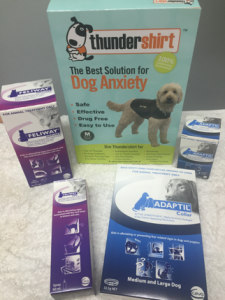Mental health issues are not just a problem for people; they occur in our pets as well. One of the most commonly encountered behavioural disorders in dogs and cats is anxiety.
We all experience the feeling of fear. Fear is a natural instinct and is important for survival; we encounter a threat or danger and our body immediately prepares to deal with it through a “fight or flight” stress response.


A phobia is an excessive persistent fear of a specific stimulus. The most common phobias are associated with noises, such as thunder, fireworks, or the vacuum cleaner out.
The brain has two main parts. The first is the “thinking centre” (the cerebral cortex) which is mainly used to learn new things. It is working when an animal is calm, relaxed, and making conscious decisions.
The second main part of the brain is the emotional centre (the limbic centre, and especially the amygdala). This part of the brain is primary when the animal is fearful or anxious. It acts as an alarm when a threat is perceived, and the animal reacts in an emotional response as a reflex.
In this situation, there is no logical thinking; the body is reacting to save its life. As a result of the activation of this emotional centre, stress hormones are released, heart rate, blood pressure and breathing rate increase, pupils become dilated, and pain sensation is reduced. The body gets ready to run away or fight.
When a dog or cat has an anxiety problem, this “danger centre” in the brain is switched on more than normal. Anxious animals therefore cannot think rationally and learn, as they are unable to relax enough to do so.
Anxiety problems are welfare problems. As veterinarians, we help our patients by assessing their problems and then either treating them ourselves or in some cases by referring them to behavioural vets or specialists.
Symptoms of anxiety can include:
Vocalising – persistent barking or howling. Dogs with separation anxiety often bark or howl without any trigger other than being left alone or being separated from their owner.
Chewing, digging or other destructive behaviour. For example owners come home to find household objects destroyed or scratch marks on the doors. This behaviour can be so excessive that self-harm can occur, like paws bleeding from damaged nails or broken teeth.
Running away. Dogs with separation anxiety who are left alone at home may try to dig and chew their way out, again with such ferocity that self-harm may occur.
Pacing or other repetitive behaviour. In the case of separation anxiety, this occurs when owners are not home, so the behaviour may not even be noticed unless videotaped.
Soiling. Some dogs (and cats) urinate or defecate in inappropriate places. In some cases this behaviour may be anxiety related, but other causes are possible as well.
Aggression. In some pets, anxiety can lead to fear-based aggression towards other animals or people.
Some of the above symptoms may not be recognised as a behavioural problem, but instead be seen as typical of a “naughty,” “difficult,” or untrained pet.
Treating Anxiety in Pets


To diagnose a behavioural problem, a veterinary visit is needed. The vet will ask a lot of questions to find out when the problems started, what the triggers are, and if there are other problems such as medical or training problems going on. They will also give the pet a full physical examination and blood, urine and other tests as needed.
Once a diagnosis has been made, a treatment plan can begin. Usually this includes behaviour modification (such as desensitisation and counter-conditioning, teaching relaxation, distracting and redirecting, environmental enrichment), management (management of the pet’s environment, avoidance and prevention of inappropriate behaviours, stable routines), non-medical support such as pheromones and thunder-shirts, and medication as required.
Mild cases, recognised early, are easier to manage and may benefit from basic behaviour modification and management treatments. So if you are worried about your pet’s behaviour, do not hesitate to contact us at Cronulla Veterinary Clinic.
